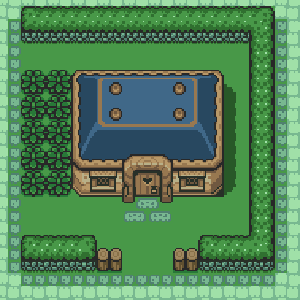Three-Quarters View
A method of portraying three dimensional space in a two-dimensional plane. Basically, it's a tilted bird's eye view perspective in which both the top and front of an object is seen at the same time, and the vertical axis indicates both height and depth.[1] Most games that have this perspective will still have character sprites as if they've being viewed straight on, though some will have a more Super-Deformed style. Very popular during the 16-bit era for JRPGs.
Despite console games having largely abandoned this in favor of full 3-D graphic, this remains popular in handheld systems due to the lower demands on the system.
This view sometimes leads to secrets being hidden on the backs of buildings.
See also Isometric Projection, Top Down View and Side View.
- Adventure
- Chuck Norris Superkicks
- Command & Conquer and Red Alert: Tanks are not exactly viewed from above, and soldiers definitely aren't.
- The computer game Lego Loco
- Chrono Trigger
- Dragon Quest
- Dragonstomper
- Elona
- ET the Extra Terrestrial
- Final Fantasy I to Final Fantasy VI.
- The Guardian Legend for the stages inside NAJU; the flying stages use Top Down View.
- Gauntlet (1985 video game) was one of the first such games.
- Ghost Manor
- The Golden Sun series.
- Indiana Jones - Temple of Doom NES game had a hybrid of this view and overhead view.
- Last Alert
- Zelda until the debut of The Legend of Zelda Ocarina of Time. (Handheld titles still use this kind of perspective.)
- The original, at least was a very strange example that mixed top-down and 3/4 view in the same game. Walls were top-down, and trees and stumps were a squashed 3/4 view.
- Zelda II the Adventure of Link primarily used a side-view for its action segments, and only used a 3/4 view for its overworld.
- The Legend of Zelda a Link To T He Past had quite a good 3/4 view for its sprites, though inside walls were top-down.
- Game Boy titles follow the same guidelines as above for the tiles, but sprites are Side View.
- The 2D Metal Gear games.
- Mario & Luigi: Superstar Saga (and thus, of course, Partners in Time and Bowser's Inside Story)
- The Mother series, though it had a different perspective in towns (and used Isometric Projection in a city)
- Pokémon. The move to the DS with Gen 4 allowed them to use more a proper perspective, though this trope still applied when in buildings. They avert the trope in a few towns in Gen 5.
- Raiders of the Lost Ark
- RPG Maker provides tilesets to create this kind of perspective.
- The original SimCity used an inconsistent mix of 3/4 and top-down perspectives; later games switched to Isometric Projection.
- Uncharted Waters 2 had this, but only in ports.
- The 2D World of Mana games:
- Wasteland
- Slime Forest Adventure
- The overhead segments of Blaster Master.
- The Dark Castle, Mirage Palace and Dragon's Hole levels in Brutal Mario, as well as other Super Mario World hacks using Seiken Densetsu 3/Secret of Mana graphics.
- ↑ technically speaking, it's a very distant bird's eye view, zoomed to very high levels, with perspective not working "properly" because of high viewing distance
